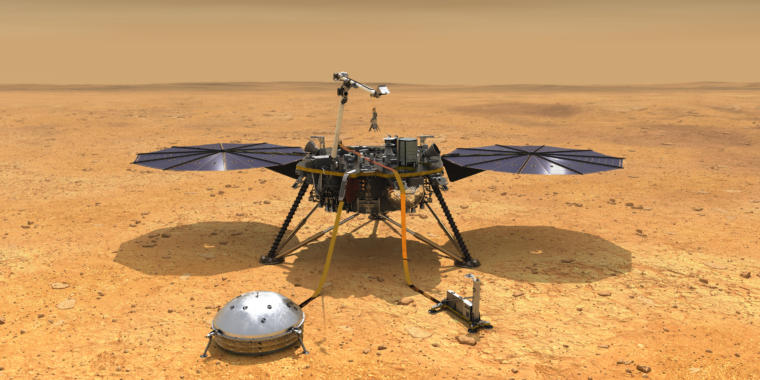
Mars appears to be a frozen expanse of red dust, gaping craters and rocky terrain on the outside – but what lies beneath its wind-blasted surface? NASA’s InSight lander may have discovered this before it breathed its proverbial last in a dust storm.
It has long been debated whether the core of Mars is solid or liquid. While there’s no way to directly observe the Martian core, InSight has tried. The seismometer, SEIS, was the first instrument to find possible evidence of a liquid core. In the meantime, its RISE (Rotation and Interior Structure Experiment) instrument had measured tiny changes in the planet’s rotation as it “wobbles” on its axis in orbit around the planet caused by the pushing and pulling of the sun’s gravity. .
“Our analysis of InSight’s radio tracking data argues against the existence of a solid inner core and reveals the shape of the core, indicating internal mass anomalies deep within the mantle,” the researchers behind the instrument write in a study. which was recently published in Nature.
Slow to RISE
RISE works by sending radio signals to Earth. By tracking changes in these signals, researchers can detect extremely small changes in location relative to our receivers. These changes are caused by fluctuations in Mars’ rotation, which are called nutations. The distance and direction the axis moved due to these fluctuations can be used to derive information about the internal composition of Mars.
The Red Planet was previously suspected to have a liquid core based on measurements of seismic waves. But detecting these changes based on radio signals proved challenging. It took a while for signals to emerge from the sound of the planet’s movements. Mars also swirls with dust storms, and storms that happened before and after InSight landed changed the planet’s rotational speed for a while. Its axis of rotation also undergoes minor changes due to the gravitational pull exerted by its moons, Phobos and Deimos.
For the RISE experiment to work, researchers needed to know exactly where InSight landed on Mars. Landers have planned landing sites, but they’re not exact — even the scientists tracking them can’t say exactly where they are until they interpret the first data the lander sends to Earth.
The first RISE data was processed by radio scientist Sebastien Le Maistre of the Royal Observatory of Belgium, and a positional estimate was uploaded to the Mars Reconnaissance Orbiter (MRO), which took a picture of the site. The image showed that InSight was located with astonishing accuracy.
You have notations in your rotation
After RISE knew exactly where on Mars its lander was, how did the observed vibrations indicate a liquid core? Nutations can be prograde (the axis moves counterclockwise relative to its surroundings) or retrograde (the opposite of that). Le Maistre and his team already knew that if Mars really did have a liquid core under a solid mantle, this should mean that the axis wobbled retrograde and also moved a little more than if the core was solid. When they tested this against the InSight data, it was a match.
“Nutation analysis based on radiometric measurements is the only technique that can provide direct estimates of [the] properties of the Martian core,” the researchers also said in the study.
Further analysis revealed that the core of Mars is most likely made of an alloy of liquid iron and sulfur, and that it constantly goes through convection, with hotter liquid rising and cooler liquid sinking. Unlike the Earth’s core, it is also thought to be completely liquid. The outer core of the Earth is an alloy of liquid iron and nickel, while the inner core is solid and made mostly of iron.
The scientists say it’s possible that Mars’ lower mantle has also melted, which would affect the size and shape of the core. A molten mantle would allow subsurface mass anomalies, regions in which material is more or less dense than the surrounding material. It turned out that one of these anomalies appears to be much deeper below the surface than the others. Anomalies may partially explain the slight flattening of both the surface and core of Mars as it rotates on its axis.
In the future, Le Maistre hopes to analyze more RISE data in the same dataset that gave away the anomalies and liquid core. There are still huge amounts of data from InSight waiting to tell us more about Mars. “RISE is not only about the deep inside, but also about the atmosphere and the rotation,” he said in a press release. “[It can] provide an orientation and rotational model that can serve as a reference for the scientific community.”
Nature, 2023. DOI: 10.1038/s41586-023-06150-0
Elizabeth Rayne is a creature that writes. Her work has appeared on SYFY WIRE, Space.com, Live Science, Grunge, Den of Geek, and Forbidden Futures. When she’s not writing, she’s transforming, drawing, or cosplaying as a character she’s never heard of before. Follow her on Twitter @quothravenrayne.

